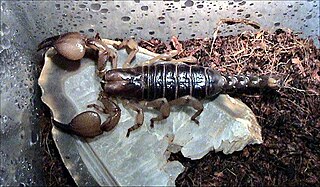
Opistophthalmus is a genus of scorpions known commonly as burrowing scorpions, tricolored scorpions, serkets, or hissing scorpions. They are found predominantly in southern Africa. They are known for making deep and elaborate burrows.

The New Holland frog, also known as wide-mouthed frog, is a large species of burrowing frog native to northern New South Wales and the eastern portion of Queensland, Australia.
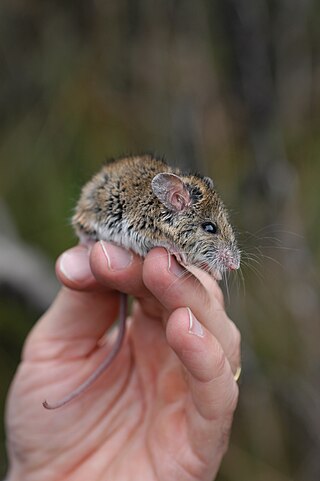
The New Holland mouse also known as a Pookila is a species of rodent in the family Muridae. It was first described by George Waterhouse in 1843. It vanished from view for over a century before its rediscovery in Ku-ring-gai Chase National Park north of Sydney in 1967. It is found only in south east Australia, within the states of New South Wales, Queensland, Victoria, and Tasmania.
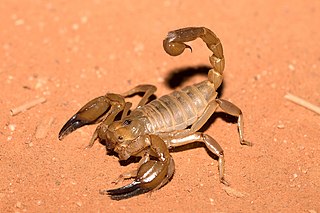
Urodacus is a genus of scorpion belonging to the family Urodacidae. It was described by German naturalist Wilhelm Peters in 1861. The type species is U. novaehollandiae. Its species are native to Australia, and dig burrows. The genus was placed in its own family in 2000. Before this, the group had been a subfamily Urodacinae within the family Scorpionidae. There are likely many undescribed, cryptic species within the genus.
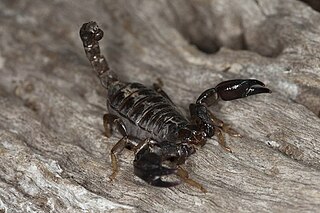
Urodacus manicatus, commonly known as the black rock scorpion, is a species of scorpion belonging to the family Urodacidae. It is native to eastern Australia.

Urodacus yaschenkoi, also known as the inland scorpion or the desert scorpion, is a species of scorpion belonging to the family Urodacidae. It is native to central Australia. It is also referred as the desert robust scorpion, because of its robust black colour and a long tail lined with a deadly hook.
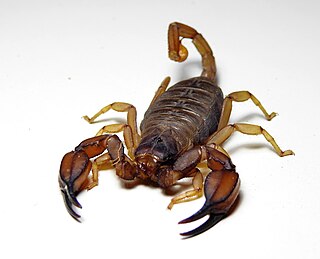
Urodacus elongatus, commonly known as the Flinders Range scorpion, is a species of scorpion belonging to the family Urodacidae. They are endemic to the Flinders Ranges of South Australia. They were described by L.E. Koch in 1977.

Urodacidae is a family containing two genera of scorpions, both of which are endemic to Australia. It was first described by British zoologist Reginald Innes Pocock in 1893. Formerly a subfamily (Urodacinae) of the Scorpionidae, it was later raised to family rank. Its sister taxon is the monotypic family Heteroscorpionidae, the species of which are confined to Madagascar.
Urodacus armatus, also known as the yellow sand scorpion or inland desert scorpion, is a species of scorpion in the Urodacidae family. It is native to Australia. It was first described in 1888 by British zoologist Reginald Innes Pocock.
Urodacus centralis is a species of scorpion in the Urodacidae family. It has a limited range in central Australia, and was first described in 1977.
Urodacus butleri is a species of scorpion in the Urodacidae family. It is endemic to Australia, and was first described in 2012.
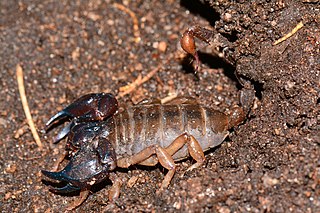
Urodacus planimanus is a species of scorpion in the Urodacidae family. It is endemic to Australia, and was first described in 1893 by British zoologist Reginald Innes Pocock.
Urodacus spinatus is a species of scorpion in the Urodacidae family. It is endemic to Australia, and was first described in 1902 by British zoologist Reginald Innes Pocock.
Urodacus giulianii is a species of scorpion in the Urodacidae family. It is endemic to Australia, and was first described in 1977 by L. E. Koch.
Urodacus lowei is a species of scorpion in the Urodacidae family. It is endemic to Australia, and was first described in 1977 by L. E. Koch.
Urodacus similis is a species of scorpion in the Urodacidae family. It is endemic to Australia, and was first described in 1977 by L. E. Koch.

Urodacus hartmeyeri is a species of scorpion in the Urodacidae family. It is endemic to Australia, and was first described in 1908 by German naturalist Karl Kraepelin.
Urodacus varians is a species of scorpion in the Urodacidae family. It is endemic to Australia, and was first described in 1963 by Australian paleontologist and Western Australian Museum curator Ludwig Glauert.

Urodacus lunatus is a rare species of burrowing scorpion in the family Urodacidae. It is endemic to the northern part of western Australia and was described in 2023.

Urodacus uncinus is a species of scorpion in the family Urodacidae. It is endemic to the northern part of Western Australia.












